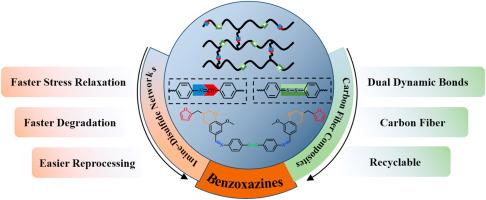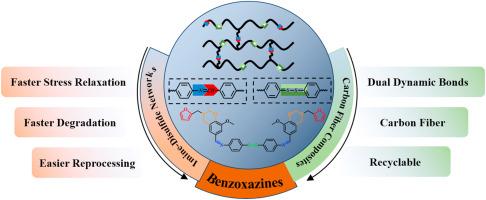用二硫化物-亚胺网络设计高性能苯并恶嗪
IF 4.5
2区 化学
Q2 POLYMER SCIENCE
引用次数: 0
摘要
为了解决苯并恶嗪树脂有限降解的挑战,在其交联网络中加入可逆共价键提供了一个有希望的解决方案。然而,单一的动态键往往不能提供足够的动态性能。在这项研究中,我们引入两个不同的动态共价键-亚胺和二硫化物-到香兰素衍生的苯并恶嗪树脂中,以提高其动态特性。与传统的苯并嗪树脂相比,这些树脂具有显著缩短的应力松弛时间(140°C, 30 s),强大的后处理能力(140°C, 10 MPa, 20 min),优异的热稳定性(800°C下炭收率54.4%)和优越的可降解性。单动态键(S-S或C=N)可使树脂在24小时内降解,而双动态键系统仅在16小时内实现完全溶解。研究表明,S-S键的初始解离降低了PVf-4AFD的交联密度,有利于C=N键的解离。这种协同作用在保持材料的机械和热性能的同时,加速了降解过程。这项工作通过建立一个双动态交联网络,有效地平衡降解率,存储模量和热性能,促进了可持续热固性聚合物的发展。该方法能够在不影响性能的情况下进行有效的后处理,为设计可降解和可回收的苯并恶嗪树脂提供了一种通用的策略。本文章由计算机程序翻译,如有差异,请以英文原文为准。


High-performance benzoxazines designed with disulfide-imine networks
To address the challenges of limited degradation of benzoxazine resins, incorporating reversible covalent bonds into their crosslinked network offer a promising solution. However, a single dynamic bond often fails to provide sufficient dynamic properties. In this study, we introduce two distinct dynamic covalent bonds-imine and disulfide-into vanillin-derived benzoxazine resins to enhance their dynamic characteristics. These resins exhibit significantly reduced stress relaxation times (140 °C, 30 s), robust post-processing capabilities (140 °C, 10 MPa, 20 min), excellent thermal stability (54.4 % char yield at 800 °C), and superior degradability compared to conventional benzoxazine counterparts. While a single dynamic bond (S–S or C![]() N) enables resin degradation within 24 h, the dual dynamic bond system achieves complete dissolution in just 16 h. The study reveals that initial dissociation of the S–S bond reduces the cross-link density of PVf-4AFD, facilitating the dissociation of C
N) enables resin degradation within 24 h, the dual dynamic bond system achieves complete dissolution in just 16 h. The study reveals that initial dissociation of the S–S bond reduces the cross-link density of PVf-4AFD, facilitating the dissociation of C![]() N bonds. This synergy, while preserving the material's mechanical and thermal properties, accelerates the degradation process. This work advances the development of sustainable thermoset polymers by establishing a bi-dynamic crosslinked network, effectively balancing degradation rate, storage modulus, and thermal properties. The approach enables efficient reprocessing without compromising performance, providing a versatile strategy for designing degradable and recyclable benzoxazine resins.
N bonds. This synergy, while preserving the material's mechanical and thermal properties, accelerates the degradation process. This work advances the development of sustainable thermoset polymers by establishing a bi-dynamic crosslinked network, effectively balancing degradation rate, storage modulus, and thermal properties. The approach enables efficient reprocessing without compromising performance, providing a versatile strategy for designing degradable and recyclable benzoxazine resins.
求助全文
通过发布文献求助,成功后即可免费获取论文全文。
去求助
来源期刊

Polymer
化学-高分子科学
CiteScore
7.90
自引率
8.70%
发文量
959
审稿时长
32 days
期刊介绍:
Polymer is an interdisciplinary journal dedicated to publishing innovative and significant advances in Polymer Physics, Chemistry and Technology. We welcome submissions on polymer hybrids, nanocomposites, characterisation and self-assembly. Polymer also publishes work on the technological application of polymers in energy and optoelectronics.
The main scope is covered but not limited to the following core areas:
Polymer Materials
Nanocomposites and hybrid nanomaterials
Polymer blends, films, fibres, networks and porous materials
Physical Characterization
Characterisation, modelling and simulation* of molecular and materials properties in bulk, solution, and thin films
Polymer Engineering
Advanced multiscale processing methods
Polymer Synthesis, Modification and Self-assembly
Including designer polymer architectures, mechanisms and kinetics, and supramolecular polymerization
Technological Applications
Polymers for energy generation and storage
Polymer membranes for separation technology
Polymers for opto- and microelectronics.
 求助内容:
求助内容: 应助结果提醒方式:
应助结果提醒方式:


